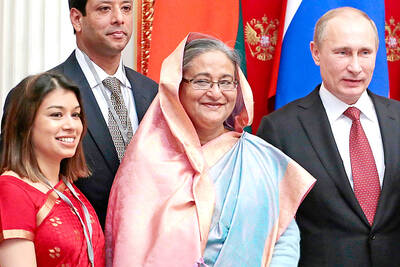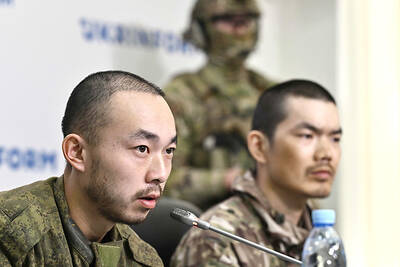The suicide bombers who have killed 10,000 people in Iraq, including hundreds of US troops, are usually alienated young men from large families who are desperate to stand out from the crowd and make their mark -- and they are not Iraqi -- a US military study found.
As long suspected, most come from abroad. Saudi Arabia, home of most of the hijackers involved in the Sept. 11,2001, attacks in the US, is the single largest source. And the pipeline is continually replenished by recruiters for al-Qaeda in Iraq.
The study, obtained by The Associated Press, profiles the suicide bombers and their support system based in part on interrogations of 48 foreign fighters who were captured or surrendered. The US command is trying to understand the system, including al-Qaeda in Iraq's recruiting, training and transportation network, so it can be disrupted before the bombers strike.

PHOTO: AFP
The report summary said interrogators concluded that most foreign fighters are Sunni Muslim men aged 18 to 30, with a mean age of 22. They are almost always single males with no children and tend to be students or hold blue-collar jobs ranging from taxi drivers to construction and retail sales.
The summary went on to describe the majority of the fighters as having six to 12 years of schooling, with very few having gone to college. Most come from families in the poor or middle classes and have six to eight siblings.
"In these large family groups, individuals seek ways to `make their mark,' to set them apart. In many ways, entering jihad gives sons a way to show themselves unique in a large family," the summary said.
Tallies from the National Counterterrorism Center in Washington showed that 949 suicide bombers killed 10,119 people and wounded 22,995 from the beginning of 2004 until now. Data compiled by the AP through its own reporting found that between April 28, 2005, and last week there were 708 incidents involving suicide bombings, with a total of 14,633 Iraqis wounded and 7,098 killed.
Author Mohammed Hafez, who has tracked data in his own separate study, Suicide Bombers in Iraq, said there have been 1,800 suicide attacks worldwide since the phenomenon began in the early 1980s. Of those, more than half have taken place in Iraq.
"There have been more than 900 suicide attacks in Iraq ... Certainly the phenomenon is growing," said Hafez, a political science professor at the University of Missouri, Kansas City.
US Rear Admiral Gregory Smith, the spokesman for Multinational Forces in Iraq, said the overwhelming majority of suicide attackers in Iraq are not Iraqi.
"Iraqis are religiously and socially opposed to suicide, requiring al-Qaeda to recruit foreigners to carry out their terror. Approximately 90 percent of the suicide attacks in Iraq are carried out by foreigners," he said.
In an interview, two senior analysts who helped question the 48 captured fighters said the picture that emerges is of a cold and calculating process that recruits young, alienated men who are social outcasts. The interrogators could not be named for security reasons.
The demand for many foreign fighters begins in places such as the dingy back streets of teeming Iraqi cities such as Mosul, where al-Qaeda still holds sway.
If an al-Qaeda cell decides it needs two suicide bombers, it puts in an order.
That request goes to Syria and to the facilitators and recruiters training young men in North Africa and Saudi Arabia.
Three months later, the bomber is delivered, military investigators and officials say.
The US military said records seized from al-Qaeda show that 40 percent come from North African countries such as Libya and Algeria and 41 percent from Saudi Arabia.

Incumbent Ecuadoran President Daniel Noboa on Sunday claimed a runaway victory in the nation’s presidential election, after voters endorsed the young leader’s “iron fist” approach to rampant cartel violence. With more than 90 percent of the votes counted, the National Election Council said Noboa had an unassailable 12-point lead over his leftist rival Luisa Gonzalez. Official results showed Noboa with 56 percent of the vote, against Gonzalez’s 44 percent — a far bigger winning margin than expected after a virtual tie in the first round. Speaking to jubilant supporters in his hometown of Olon, the 37-year-old president claimed a “historic victory.” “A huge hug

Two Belgian teenagers on Tuesday were charged with wildlife piracy after they were found with thousands of ants packed in test tubes in what Kenyan authorities said was part of a trend in trafficking smaller and lesser-known species. Lornoy David and Seppe Lodewijckx, two 19-year-olds who were arrested on April 5 with 5,000 ants at a guest house, appeared distraught during their appearance before a magistrate in Nairobi and were comforted in the courtroom by relatives. They told the magistrate that they were collecting the ants for fun and did not know that it was illegal. In a separate criminal case, Kenyan Dennis

A judge in Bangladesh issued an arrest warrant for the British member of parliament and former British economic secretary to the treasury Tulip Siddiq, who is a niece of former Bangladeshi prime minister Sheikh Hasina, who was ousted in August last year in a mass uprising that ended her 15-year rule. The Bangladeshi Anti-Corruption Commission has been investigating allegations against Siddiq that she and her family members, including Hasina, illegally received land in a state-owned township project near Dhaka, the capital. Senior Special Judge of Dhaka Metropolitan Zakir Hossain passed the order on Sunday, after considering charges in three separate cases filed

APPORTIONING BLAME: The US president said that there were ‘millions of people dead because of three people’ — Vladimir Putin, Joe Biden and Volodymyr Zelenskiy US President Donald Trump on Monday resumed his attempts to blame Ukrainian President Volodymyr Zelenskiy for Russia’s invasion, falsely accusing him of responsibility for “millions” of deaths. Trump — who had a blazing public row in the Oval Office with Zelenskiy six weeks ago — said the Ukranian shared the blame with Russian President Vladimir Putin, who ordered the February 2022 invasion, and then-US president Joe Biden. Trump told reporters that there were “millions of people dead because of three people.” “Let’s say Putin No. 1, but let’s say Biden, who had no idea what the hell he was doing, No. 2, and